How To Pick The Right Size Baseball Glove
In baseball and softball, a fielding glove is i of the near important tools you'll need to become a successful player. In a lot of ways, it'south the final piece to that spectacular diving catch in the outfield or what you lot need to stop that line drive down the third base line. Not all baseball gloves and softball gloves are created equal in terms of size and material. What size glove yous should apply largely depends on the position you play, only there are also other factors that assistance determine exactly which glove you should equip yourself with.
In this guide, we will encompass:
- Baseball glove sizing chart
- Fastpitch softball glove sizing nautical chart
- The proper style to measure a baseball or softball glove
- The parts of a baseball and softball glove
- Guidelines for selecting a glove
- Differences in the gloves by position
- Types of gloves by position
Baseball Gloves Sizing Chart by Position and Age
The chart below shows an gauge of the size range of the glove for a specific thespian for baseball:
| Age | Catcher | Get-go Base | Second Base/ Short Stop | Third Base | Pitcher | Outfield |
|---|---|---|---|---|---|---|
| Under 7 | 29.5 - thirty" | eleven.5" | 8 - 10.v" | viii - ten.5" | eight - ten.5" | 9 - ten.5" |
| 8 - x | 30 - 31" | 11.v - 12" | 10.v - 11.25" | 10.five - 11.5" | x.5 - eleven.v" | x - 12" |
| 11 - 13 | 30 - 32.5" | 11.5 - 12" | 11 - xi.5" | eleven - eleven.75" | 11.5 - 12" | 11.75 - 12.75" |
| Over 14 | 32 - 34.5" | 12 - thirteen" | 11.25 - xi.5" | xi.v - 12" | 11.5 - 12" | 12 - xiii" |
Fastpitch Softball Glove Sizing Chart by Position and Age
The nautical chart below shows an estimate of the size range of the glove for a specific actor for fastpitch softball:
| Age | Catcher | First Base of operations | 2nd Base/ Short End | 3rd Base | Pitcher | Outfield |
|---|---|---|---|---|---|---|
| Under vii | 29.5 - 30" | 11.5" | 8 - 10.5" | viii - 10.5" | 8 - 10.5" | 9 - 11" |
| 8 - 10 | 30 - 32" | eleven.5 - 12" | x.5 - 11.25" | 10.five - 11.five" | 10.5 - 11.5" | x - 12" |
| 11 - 13 | 31 - 32.v" | 12 - 13" | 11.25 - 12" | eleven.75 - 12.v" | 11.5 - 12.v" | 11.75 - 12.v" |
| Over 14 | 33 - 35" | 12 - 13" | 11.v - 12.5" | 11.75 - 12.5" | 11.5 - 12.five" | 12 - xiii" |
Slowpitch Softball Glove Sizing Nautical chart past Position
The chart below shows an estimate of the size range of the glove for a specific player for slowpitch softball:
| Showtime Base of operations | Second Base/ Brusk Terminate | Tertiary Base | Bullpen | Outfield |
|---|---|---|---|---|
| 12 - 13" | 11.five - 12.5" | 11.75 - 13" | eleven.5 - 13" | 12 - 15" |
Measure a Baseball/Softball Glove Properly
When trying to find out how long a glove is, yous can look on the thumb or pinky finger and you should run across the size etched in the leather at that place. The sizes range from 8 to 15 inches, and to 35 inches for catcher'southward mitts. To measure a glove that does not have a size, take a fabric tape measure and mensurate from the top of the alphabetize finger, downwardly along the glove, to the center of the heel of the glove:
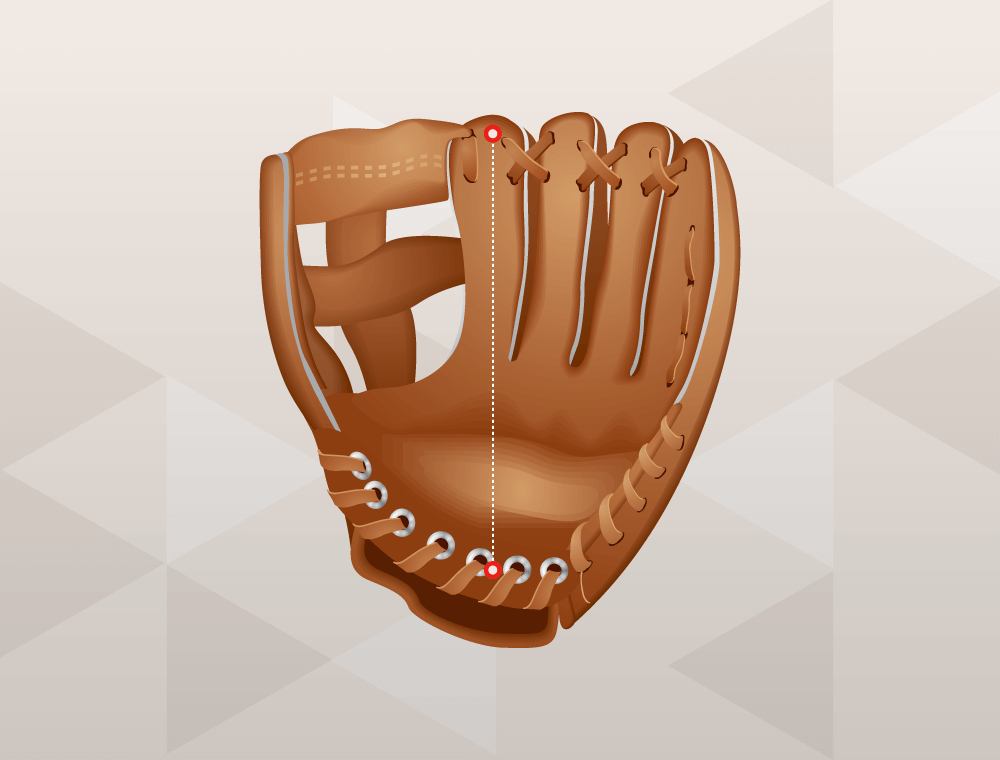
Now that you know how to measure the glove, you can use that measurement and reference our baseball glove sizing chart to decide how to a size a baseball game glove for your position and age group. If you're looking sizing guidance for youth baseball gloves, y'all tin can follow the same chart.
Parts of a Baseball/Softball Glove
In that location are 4 major of import parts to a baseball game or softball glove and they are specified below:
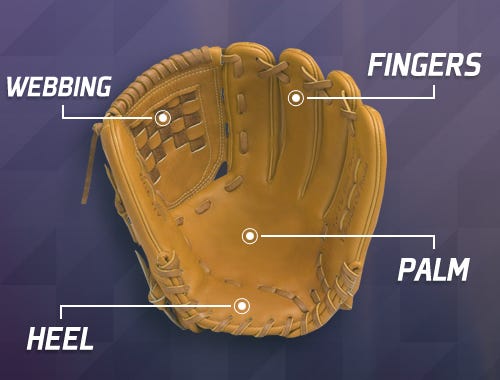
- Webbing: With every baseball and softball glove you will notice that it volition have a web which connects the thumb of the glove to the fingers in lodge to help catch balls and keep them secure in your glove. Glove webs come in many different styles and sizes, varying mainly dependent on the personal preference of the actor of the position they play.
- Fingers: When it comes to fingers on a baseball or softball glove, there is not really much difference other than the length of the fingers to make for a longer glove. However, players will either identify 1 finger in the pinky hole, or place 2 fingers in information technology, making the glove close differently depending on their preference.
- Palm: The palm or pocket of a baseball and softball glove piece of work with the spider web to keep the ball secure in the glove once it is caught. Additionally, the palm provides padding to the hand to assist reduce stings when catching balls directly in the palm expanse.
- Heel: The heel of a glove is located below the palm and helps provide most of the structure to the shaping of the glove. This part of a baseball or softball glove is typically the stiffest in a new glove and therefore volition provide most of the overall padding to the lower part of the paw and upper wrist.
Guidelines for Selecting a Glove
When buying a glove, there are a few basic terms that have to exist defined commencement:
- Type of throw: Refers to which mitt a player uses to throw the ball (not which mitt the glove is on), depending on if the player is a righty or a lefty.
- RHT: Correct hand thrower. Means the actor throws with his or her correct paw and wears the glove on the left.
- LHT: Left mitt thrower. Means the role player throws with his or her left manus and wears the glove on the right.
Nosotros've already mentioned that the all-time glove for you depends on which position you play. Merely there are other factors too:
Pocket Size
The pocket size you select volition depend on the position you play. For instance, an outfielder'due south glove will take a bigger pocket than that of a middle infielder, assuasive outfielders to catch fly balls with more than ease. Middle infielders (shortstops and second baseman) unremarkably have a shallower pocket, which allows them to get the ball out of the glove quicker, especially of import on double plays.
Webbing
There are unlike types of webbing found in gloves for baseball and softball players. The blazon of webbing near mutual for infielder's gloves contains a looser stitch which gives more than command in hopes of getting the ball out quicker - information technology also doesn't pick up big clumps of clay with information technology. Outfielders volition typically choose gloves with open webs to let for visibility while shielding the sunday. Traditionally, there are viii dissimilar kinds of webbing to cull from:
- Closed/Basket Web
- H-web
- I-web
- Trapeze Spider web
- Modified Trapeze Spider web
- Two-piece Closed Spider web
Types of Baseball game Glove Spider web Designs
As previously discussed, there are viii general types of web designs for baseball gloves. There are more branches of designs, simply these are your core eight.
Airtight/Basket Web
Airtight web and basket web gloves are designed to conceal the brawl in the glove. They are typically used past catchers and pitchers, equally well equally some middle infielders. They're easy to shut with extra flexibility in the design.
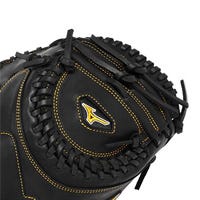
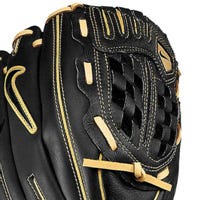
H-web
Commonly used by outfielders and third basemen the H Web design, also known every bit dual post web, offers a sturdy yet flexible construction while providing the power to meet through webbing for pop ups. Outfielders can use this blueprint as well.
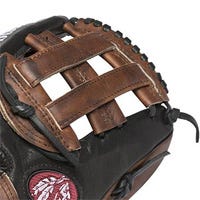
I-web
The I Spider web designs is used mostly past centre infielders due to the open up webbing, which allows clay and droppings to fall out and not go stuck while fielding and throwing a ball. It too helps shield the dominicus from fly balls.
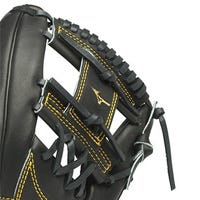
Trapeze Web
Trapeze web gloves are used nearly exclusively by outfielders. The design has a deep pocket for maximum catching range and allows for visibility while shielding the sun from your optics.
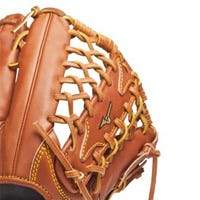
Modified Trapeze Spider web
The modified trapeze web is a versatile pattern that can be used by outfielders, infielders, and pitchers. It'southward differentiated from the standard trapeze blueprint by the strip of leather on the meridian of the spider web, which adds stability.
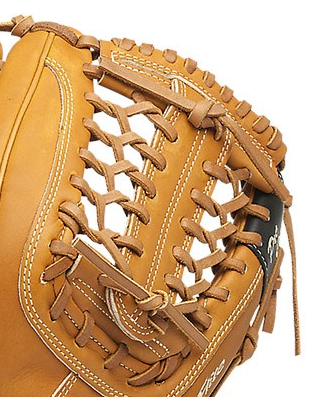
Two-Piece Closed Web
A perfect glove for pitchers, the two-piece airtight web blueprint offers an piece of cake identify to conceal your hand and the brawl while on the mound.
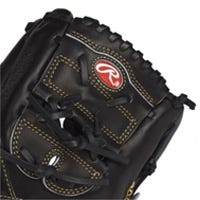
Padding
Padding preference is some other affair to consider. The amount of padding you have on your glove depends on the position yous play. Catcher's mitts feature more padding to protect their hands from pitchers' throws. Other positions, such equally outset and third base, may also need more padding. Recently, the popularity of extra wrist padding has grown, specially at the corner infield positions.
Wrist Adjustments
Some gloves are made with wrist adjustments that allow players to make the glove fit snug to their paw, allowing them to put on and take off the glove with ease. These tin can either exist Velcro, a buckle system, laced, or a D-ring fastener.
Material
Gloves tin be fabricated of many unlike types of materials including leather, synthetic materials, mesh, and treated leather. Leather is the preferred cloth amid players due to their durability and condolement. Players may opt for treated leather gloves which are preconditioned with oils for quicker break in period. Some adopt a mesh backed glove for a lighter glove. For younger players, a constructed glove is good it's the lightest and almost inexpensive glove available.
Baseball Glove Web Pattern Chart by Position
Certain positions crave a baseball glove with a item webbing. Cheque out the list below for common webbings you'll find for each position:
| Position | Web Pattern | Description |
|---|---|---|
| Outfielders | H-web Trapeze Modified Trapeze | Bigger, deeper pockets |
| Eye Infielders (SS/2B) | I-spider web Two-piece Closed | Shorter, shallow pocket |
| 3rd Basemen | H-web Modified Trapeze Closed | Stronger, deeper pockets |
| Pitchers | Basket Two-piece Closed Closed Modified Trapeze | Conceal ball and hand when selecting a pitch grip |
| Catchers | Two-piece Airtight Closed | Conceal signals to bullpen Stronger, deeper pockets Extra padding for hard throws |
| First Basemen | 2-slice Closed Closed | Stronger, deeper pockets Extra padding for hard throws |
Fastpitch Softball Glove Web Blueprint Chart by Position
Like baseball gloves, positions in fastpitch softball require a specific webbing:
| Position | Description |
|---|---|
| Middle Infielders (SS/2B) 1st Basemen Outfielders Catchers | Open web that allows for quicker transfer to throwing hand |
| Pitchers 3rd Basemen Outfielders | Closed spider web that provides more support for outfielders and shields ball in pitchers glove |
Youth vs. Developed Gloves
A youth glove is designed for younger players with smaller hands. They are typically cheaper than the developed gloves and are much easier to close. The youth gloves are not made of the same high quality leather, simply the materials they are made of make them easier to shut. Youth gloves take smaller, narrower fingers and should be used for a player under 10 years erstwhile. They sometimes tin can be used for a player up to 12 years sometime, simply after and so, kids should exist using adult gloves. To fit an adult glove onto a younger histrion's hand, the back of the wrist tin be tightened. This is done on softball gloves with a Velcro strap, but on baseball gloves, the glove needs a small re-lacing. The flick below shows the difference of how a tightened glove looks compared to a non-adjusted one.
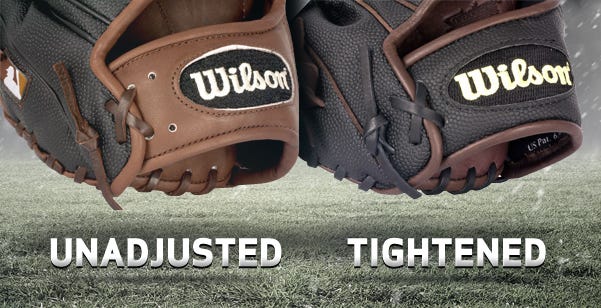
Differences Between Gloves by Position
One of the nigh important things to continue in mind when information technology comes to buying a glove is the different styles and types you tin can cull from. With each glove, you will have different types of webs and pockets, and the selection of the best glove for you depends on the position you play.
Types of Gloves by Position
Depending on the position you play, there are specific glove designs. From the web to the fingers, having the correct glove for your position tin make all the deviation. Here is a breakdown of each positional glove and why they are of import.
Catcher's Mitts
A catcher's glove is more commonly referred to as a catcher's mitt because information technology does non have separately cut fingers like other positions. This allows catchers to catch fastballs for an unabridged game without wearing down quickly or the catches becoming painful. For this reason, catchers' mitts tend to be very potent correct off the shelf and take a while to suspension in. Many catchers buy their replacement mitt a few months earlier they call up their one-time manus will habiliment out and so they accept fourth dimension to pause their new glove in. Catcher mitts tend to have a closed pocket because they can be fastened with the well-nigh lacing and accept the almost abuse without breaking.
There is a deviation between baseball and softball catcher'south mitts. The softball catcher's mitt has a deeper pocket and thinner side walls to accommodate for the bigger brawl. Catcher's mitts are also measured differently. Instead of the standard measuring, they are measured effectually the circumference of the glove to capture the entire catching expanse of the mitt. The standard size range is from 29.5 to 34.5 inches for baseball and from 29.5 to 35 inches for softball.
First Baseman's Gloves
A first baseman's glove is very similar to the catcher'southward paw with the exception that it is longer and doesn't have every bit much padding. It'southward designed to have the same catching surface area as a catcher'south glove, but is flexible for scooping throws out of the dirt. Kickoff basemen'southward gloves are stronger than a standard glove so that the fingers exercise not flop back like a regular fielder'due south glove would. They also have open web designs to allow the pocket to be a little deeper and lighter than a closed pocket. Outset basemen's gloves normally start being worn at age 10 or older, because it can be difficult for younger kids to close the large glove. The typical size range for both baseball and softball is from xi.5 to 13 inches.
Pitcher's Gloves
These gloves won't have equally much padding equally other gloves and instead rely on being comfortable. They're normally larger than other gloves to allow pitchers to movement their easily effectually to grip the ball and hide their manus movements from the batter before a pitch. A pitcher doesn't need to be every bit worried every bit other players about the performance of their glove. But the comfort is important since they are constantly catching and will often have to cease line drives hitting dorsum through the centre. It's also important to make sure the glove isn't also heavy. Many manufacturers brand light versions of high-end gloves with special materials that weigh significantly less than standard gloves.
Infield Gloves
These smaller gloves are made to let for quick plays like a double play in the middle infield. They are shorter and have a shallower pocket than other gloves. Infielders typically want an open pocket that makes it easy to get the brawl out quickly. This is typically an I-spider web, post web, Dual Mail web, or modified trapeze pocket. The only position that sometimes wants a closed pocket is third base. This is considering third base gets harder hits that a closed pocket can handle better than an open ane will. The standard size for a baseball infield glove is 11.25 to 12 inches, and 11.five to 12.5 inches for softball. For softball players, there aren't as many selections in terms of webs considering of the large ball, then the choices will be limited.
Outfield Gloves
These larger gloves are fabricated for diving catches and to take hold of fly balls. This ways that the gloves are longer and deeper with extra support in the fingers. The pocket designs for baseball are typically open with the main options existence a modified trapeze and an H-spider web. These pockets are the best for long extension plays that need to go along the brawl in the glove, such every bit diving plays and snowfall cones. For softball, the pockets can be closed webs, because they need to exist extra deep to business relationship for the size of the softball. The typical size of an outfielder's glove is 9 to xv inches for baseball and 9 to fifteen inches for softball.
Explore Baseball game Monkeys option of baseball gloves and softball gloves. Shop by position, size, or make! One yous've selected a glove, cheque out our guides on how to break in a glove and how to care for your new glove!
How To Pick The Right Size Baseball Glove,
Source: https://www.baseballmonkey.com/learn/baseball-softball-glove-buying-guide
Posted by: williamshemperess.blogspot.com


0 Response to "How To Pick The Right Size Baseball Glove"
Post a Comment